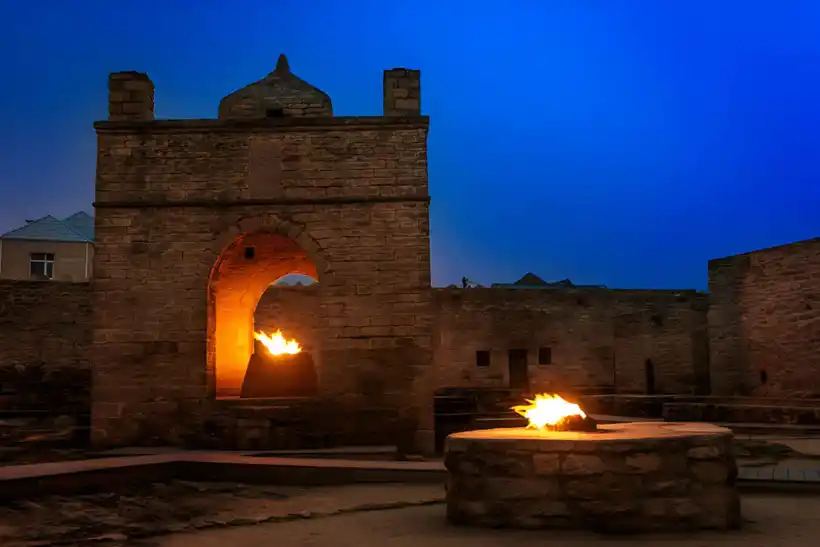
Yanar Dag, also known as the “Burning Mountain” or “Fire Mountain,” is a remarkable natural wonder in Azerbaijan. For more than seven decades, this incredible phenomenon has been continuously burning due to natural gas beneath the ground. The flames highlight the astonishing power of nature and provide an unforgettable experience for those who come to see it.
A Natural Phenomenon
Yanar Dag means “burning mountain” in Azeri, and that’s exactly what it is. Legends say the fire started in different ways, like in the 1950s a shepherd dropping a lit cigarette. However, records show that Yanar Dag has been burning continuously since at least the 13th century when Marco Polo visited the area. This captivating fire has turned the mountain into a special place that attracts tourists from all over the globe.
An Unforgettable Experience

As visitors approach Yanar Dag, they are greeted by a surreal sight. Flames dance and flicker, casting an ethereal glow against the darkened backdrop. The constant supply of natural gas creates flames that can reach up to three meters in height. Creating an extraordinary display of fire that captures the imagination.
The flames at Yanar Dag shine brightest in the evening, when the darkness makes them even more dazzling. The glowing flames provide a unique opportunity for photographers to capture striking images. The contrast between the fire and the surrounding landscape adding to the allure.
Exploring Burning Mountain
Located approximately 25 kilometres northeast of the capital city of Baku, makes it easily accessible for tourists. Visitors can embark on a short journey from Baku to witness this natural wonder firsthand. The site offers viewing platforms and walkways that ensure a safe and enjoyable experience for all.
As visitors approach the hillside, they can feel the warmth radiating from the flames, adding to the sensory immersion. The rhythmic crackling and the distinct scent of burning gas create an ambiance unlike any other. Explorers can observe the flames up close. They feel a sense of wonder and fascination at this perpetual display of nature’s power.
Inspiration for Zoroastrian Religion and Historical Connections

Yanar Dag’s eternal flames hold significant historical and cultural importance. The region’s ancient inhabitants, the Zoroastrians, were deeply influenced by the natural fires they encountered, including those at Yanar Dag. The Zoroastrian faith, founded by the prophet Zoroaster in ancient Persia (present-day Iran), incorporated the concept of sacred fire worship. The eternal flames of Yanar Dag and other similar sites were revered as manifestations of the divine.
Furthermore, Yanar Dag might have captivated the famous explorer Marco Polo as he journeyed along the Silk Road. His descriptions of “a hill full of fire” are believed to refer to Yanar Dag. This connection between Marco Polo and Yanar Dag reinforces the long-standing reputation of this captivating natural wonder. It serves as evidence of how Yanar Dag has intrigued travelers and captured the imagination across centuries.

Scientific Explanation of Burning Mountain
The scientific explanation behind Yanar Dag’s perpetual flames lies in the vast underground natural gas reserves. These reserves contain methane gas, which seeps through the porous rock layers. Various factors, including natural or human-induced sparks, ignite it. The presence of ongoing gas emissions sustains the fire. Allowing it to burn continuously without the need for external fuel sources.
Preserving a Natural Treasure
As a unique natural phenomenon, preserving Yanar Dag is of utmost importance. Authorities have implemented measures to ensure the sustainability of the site. They are carefully monitoring the flame and responsibly managing the surrounding areas. By striking a balance between accessibility and conservation, Azerbaijan aims to protect this extraordinary wonder for generations to come.
This Burning Mountain stands as a testament to the captivating forces of nature. The eternal flames, fueled by underground natural gas reserves, create a mesmerizing spectacle that draws visitors from far and wide. With its unique charm, Yanar Dag continues to leave an indelible mark on all who have the privilege of witnessing its fiery majesty. It stands as a reminder of the fascinating and awe-inspiring wonders our planet holds, while also providing a glimpse into the cultural and historical significance it holds for the Zoroastrian faith and explorers like Marco Polo.



